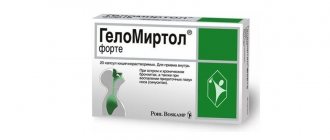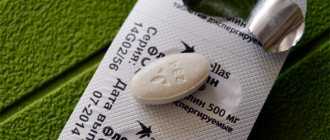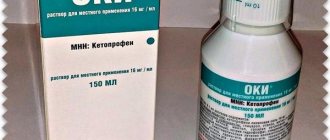Most often, the cause of sore throat is bacterial flora. Therefore, in order to cope with the disease, antibiotics are necessary. Amoxicillin for sore throat is one of the most commonly prescribed medications. The drug has a wide spectrum of antibacterial activity, that is, it is destructive against many microbes that can cause inflammation of the tonsils.
This antibiotic is inexpensive. Its effects are well known to doctors, since the drug has been used in otolaryngology and other areas of medicine for a long time.
Composition of the drug and its therapeutic effects
Amoxicillin belongs to the group of penicillins, the main action of which is to kill bacteria. This is possible due to the composition of the drug. Its main active ingredient is amoxicillin trihydrate. It is this that has a destructive effect on bacterial cells, destroying their structure.
The following therapeutic effects of the drug can be distinguished:
- Destruction of harmful flora that causes sore throat. Amoxicillin is dangerous for staphylococci, streptococci and other microbes that cause purulent inflammation of the tonsils.
- Relieves the symptoms of sore throat by quickly reducing the number of microbes. After two days of continuous treatment or even sooner, a person will notice relief. His body temperature should stabilize, his throat will stop hurting, and his breathing will become easier. The patient will be able to eat normally.
- Prevention of complications of tonsillitis. The wrong approach to therapy can cause serious health problems. Taking Amoxicillin allows you to destroy harmful flora and prevent damage to the joints, heart or kidneys. However, a doctor must prescribe the medicine.
The undoubted advantage of the drug is its high bioavailability. This means that it easily penetrates the site of inflammation (in this case, the tonsils) and helps eliminate it. The drug is excreted unchanged, so a few days after completion of the treatment course it will not remain in the body.
Release form
Amoxicillin can be found in three formulations. The drug is sold in capsules of 500 and 250 mg and in tablets of 200, 400 and 500 mg. Doctors prescribe Amoxicillin for sore throat in adults in this particular release form.
The drug can also be purchased in granules, which are contained in a bottle. A suspension is prepared from them. To do this, the granules are dissolved with warm boiled water. This form of release is more suitable for treating children, since it will be difficult for them to swallow the capsules.
The drug is not released in solution for injection.
When is Amoxicillin prescribed for angina?
Although in 85% of cases sore throat is caused by bacteria, the viral and fungal nature of the disease cannot be ruled out. Only a doctor can determine which pathogenic flora caused the inflammation. Amoxicillin for sore throat in adults and children is prescribed only when the disease is a consequence of bacterial infection of the tonsils. In other cases, taking the drug will not allow recovery and may even aggravate the inflammatory process.
Another feature of Amoxicillin is its limited effect. The fact is that some bacteria have developed resistance to it, that is, resistance. In such a situation, treatment with the drug will not cope with the disease. Therefore, if after 2-3 days from starting the drug there is no improvement, a change in antibiotic is required. At the same time, a swab is taken from the throat for LHC culture. This analysis makes it possible to clarify what substances the microflora that causes inflammation of the tonsils is sensitive to.
Sometimes patients independently decide to stop treatment after improvement has occurred. This cannot be done, since it is impossible to cope with bacterial sore throat in 2-3 days. The minimum course of treatment is 5 days. The decision to complete it must be made by the doctor. Untreated sore throat increases the likelihood of complications. It will be difficult to cope with such a disease.
Amoxicillin is prescribed not only for sore throat, but also for other infections: otitis media, sinusitis, sinusitis, frontal sinusitis, pneumonia, cystitis, enteritis, etc. Doctors recommend the drug only when the inflammation was caused by microbes sensitive to this drug.
Amoxicillin - a cure for sore throat: instructions and use
A sore throat may appear due to an infectious disease, which, in turn, is provoked by viruses and bacteria; sore throat is one of these ailments.
Diseases caused by bacteria are treated with antibiotics. You also cannot do without their use in case of a viral infection if there are complications. In their absence, the disease is relatively mild and requires only symptomatic intervention in the inflammatory process.
Amoxicillin is a semi-synthetic antibiotic
Its molecular weight is 365.41, trihydrite content is 419.45 and sodium salt content is 387.89.
It belongs to the penicillin group, is characterized by a wide range of actions, is acid-stable and is destroyed by penicillase. The drug is insoluble in hexane, benzene, ethyl acetate and acetonitrile.
The common medical name is Amoxicillin trihydrate.
The international term is denoted in Latin letters - Amoxicilin. Trade name: Trimox, Ospamox, Amoxil.
As a rule, doctors prescribe amoxicillin for sore throat, the appearance of which was provoked by streptococci, staphylococci and some other types of microorganisms.
How is the treatment carried out?
The medicine must be taken after meals. To do this, it can be purchased in powder form for preparing a suspension or in tablet form.
After oral administration, it begins to act within 1/3 of an hour, with an active time of about eight hours.
The suspension is prepared as follows: pour distilled water up to the mark on the bottle and shake.
Store the resulting medicine in the refrigerator for no more than two weeks.
Benefits of treatment with Amoxicillin:
- Can be given to children from infancy, since the antibiotic is completely safe and has a quality certificate;
- Quickly absorbed into the walls of the gastrointestinal tract (gastrointestinal tract);
- The antibiotic works in all fluids and tissues of the human body. The exception is usually the brain and cerebrospinal fluid;
- An ideal remedy for otitis, sore throat, sinusitis and other types of diseases.
Also an integral advantage of this drug is its low, affordable price.
How to calculate the dose for children: instructions
To treat children with sore throat, you must follow the following scheme:
- For children under two years old. The calculation is made using this form: 20 mg per 1 kg of body weight. Take the medicine three times a day, the course of treatment is 5-12 days. Of course, this period depends on the complexity of the disease rather than on the use of antibiotic drugs;
- From 2 to 5 years, 0.125 g 3 times a day;
- From 5 to 10 years. At this age, you can already take 0.25 g three times a day;
- Over 10 years and with a weight over 40 kg, the daily dose is 0.5 g 2/day. If the disease is acute, it can be increased to 0.75-1.0 g.
But every parent should remember that before starting adult/child treatment, you must carefully read the instructions attached to the drug, and also consult with a specialist, so as not to, for example, cause anaphylactic shock.
Side effects:
- Vomit,
- Diarrhea,
- Pseudomembranous colitis,
- Stomach upset,
- Agranulocyte.
Who is not recommended to use Amoxicillin:
- Pregnant women during lactation. But its use is possible only if the benefit to the mother outweighs the potential threat to the intrauterine baby, and then only after a number of studies have been conducted.
- With great caution, drugs should be used for bleeding in the anamnesis, as well as for renal failure;
- People with diseases of the gastrointestinal tract (gastrointestinal tract) that occur in a closed form (colitis, for example), which manifests itself while taking antibiotics for sore throat;
- In case of polyvalent hypersensitivity to the basic elements of the drug.
In addition, treatment is not recommended for persons suffering from bronchial asthma, allergic diathesis, hay fever, lymphocytic leukemia; doctors announce other contraindications after reviewing the patient’s medical record and conducting laboratory tests.
If the drug is contraindicated for the reasons stated above, you should consult a doctor who will select an equally effective replacement for this antibiotic drug. If this is not possible, you can read reviews and ask your pharmacist for advice. In general, of course, it is better to find time to make a visit to a local clinical facility.
Amoxicillin dosage chart. Doses and regimens for the treatment of angina with Amoxicillin
Symptoms of overdose:
- Nausea;
- Vomit;
- Diarrhea;
- Dehydration of the body.
In such cases, it is necessary to take measures such as gastric lavage with a saline, permanganate solution, take activated carbon (per 10 kg of body weight - 1 tablet) or a laxative, mainly with maintaining the water-electrolyte balance of the body. Throughout this time, the patient should be completely calm and remain in bed until the condition returns to normal.
In addition to the treatment of bacterial sore throat, amoxyllicin has a number of other purposes.
Specialists can prescribe treatment for diseases such as:
- Bronchitis, pneumonia;
- Pharyngitis, sinusitis, urethritis, cystitis;
- Cholecystitis, peritonitis, cholangitis;
- Meningitis, leptospirosis, listeriosis;
- Shonorea and for some other diseases.
If amoxicillin is prescribed, the sore throat will go away immediately, of course, not without proper medical supervision and proper use of the drug.
Features of taking Amoxicillin
The drug has different dosages and release forms. Therefore, a doctor should tell you how to take Amoxicillin for a sore throat. The dose largely depends on the patient’s age, his body weight and the severity of the inflammatory reaction.
If a person develops a purulent form of sore throat, then the daily dose for adult patients is adjusted to 3000 mg. It is divided into three steps. The interval between them should be exactly 8 hours. Sometimes the daily dose is divided into 2 or 4 doses. The decision remains with the doctor who is treating the patient.
If the sore throat is uncomplicated, then adult patients are advised to take no more than 750-1500 mg of the drug per day. This dose is also divided into 3 parts.
There are some features of the treatment of patients with kidney problems. The fact is that about 80% of the drug is excreted by the urinary system. Therefore, for such patients, the dose is reduced or the intervals between doses are increased.
Amoxicillin is taken orally only. The drug must be taken with a sufficient amount of water. The tablet is taken either before or after a meal. The drug cannot be crushed. Capsules and tablets are swallowed whole. It is for this reason that this form of release is not suitable for treating children.
It is important to maintain equal intervals between taking the medicine. Most often, for angina, the dose is divided into 3 times. Therefore, you need to take the drug every 8 hours.
The doctor must select such a dosage of the drug so that the patient can take one rather than several capsules. This is especially true for patients with sore throat, since the process of swallowing is accompanied by increased pain in the throat.
Side effects
Despite the multiple advantages of the drug, it has a number of side effects. These include:
- allergic reactions (first of all, a person develops skin rashes);
- joint pain, joint inflammation;
- increased irritability;
- intestinal upset with diarrhea and flatulence;
- nausea and vomiting;
- superinfection (exacerbation of sore throat);
- dizziness.
Most often, patients tolerate the drug well. Undesirable manifestations from the body rarely occur. The most common side effect from taking Amoxicillin is dysbiosis. In order to minimize the likelihood of developing intestinal problems, you need to take the drug before meals or immediately after meals. It is possible that the doctor will additionally prescribe eubiotics and probiotics.
Severe allergic reactions, such as anaphylactic shock or Quincke's edema, rarely develop. This can happen in those people who have individual intolerance to penicillins. Therefore, caution should be exercised when taking the drug for the first time.
If suddenly a person notices some unusual symptoms that he is unable to explain, he should seek medical help. Allergies and other side effects caused by Amoxicillin are a reason to replace the drug.
Contraindications and side effects
Being an antibiotic agent, amoxicillin has a number of contraindications.
The medicine may cause side effects in case of overdose or individual intolerance to some components of the drug.
At the same time, side effects can manifest themselves in the most unexpected ways, affecting various systems and organs of the human body.
Contraindications to the use of the drug include:
- renal failure;
- liver dysfunction ; _
- lymphocytic leukemia;
- infectious mononucleosis;
- any diseases of the intestines and stomach ;
- hypersensitivity to the components included in the drug. A relative contraindication in which the antibiotic can be taken with caution and in reduced doses.
Remember! Patients with chronic tonsillitis, as well as pregnant and lactating women, are not recommended to take amoxicillin - in such cases it is advisable to choose a drug with a similar effect.
Possible side effects include:
- disorders of the stomach and intestines;
- nausea and vomiting;
- dysbacteriosis;
- diarrhea;
- deterioration of the general mental state (depressed mood, depression, sleep disorders, anxiety, overexcitation);
- redness of the skin and the development of rhinitis and conjunctivitis (with a predisposition to allergies to medications);
- Quincke's edema.
Typically, such side effects when sensitive to ingredients appear immediately.
In such cases, it makes no sense to continue treatment with amoxicillin: you should consult your doctor about the possibility of replacing the antibiotic with a similar medicine.
Treatment in childhood
Amoxicillin for sore throat in children can be used from an early age. However, it must be prescribed by a doctor. Parents should not decide on their own to start antibiotic therapy, as this can be dangerous.
If a child 2-5 years old is diagnosed with purulent tonsillitis, then he is prescribed no more than 0.125 mg per day. At the age of 5-10 years, the daily dose of the drug increases to 0.25 mg. Adolescents over 10 years of age are advised to take 1500 mg per day.
If the child’s age does not exceed 2 years, then the drug is calculated based on his body weight. For every kilogram of weight, 20 mg of the drug is taken. It is recommended that children be prescribed Amoxicillin in the form of a suspension. Tablets and capsules may be offered to children 3 years of age or older.
Amosin for sore throat: instructions for use
Sore throat (or acute tonsillitis) is an inflammation of the lymphoid tissue of the pharynx, accompanied by general pathological manifestations of the body. In terms of prevalence, it is second only to ARVI and influenza.
Sore throat is a serious health threat. Usually people do not pay due attention to this disease, considering it mild and going away on its own. Someone is engaged in inadequate treatment.
An irresponsible attitude towards health brings the following serious complications:
- Abscesses;
- Lymphadenitis;
- Otitis;
- Laryngeal stenosis;
- Complications on the heart, joints (rheumatism), transition to a chronic form.
Does Amosin treat sore throat?
In addition to symptomatic treatment of inflammation (gargling with antiseptics, taking antipyretics, antihistamines, immunostimulants, vitamins, physiotherapy), the first line in the treatment of banal (the most common) catarrhal, follicular and phlegmonous tonsillitis is taking antibiotics, that is, etiotropic treatment.
Due to the mutation of microorganisms, resistance (insensitivity) to previously successfully tried drugs is observed.
Amosin - a domestic invention, is a latest generation, broad-spectrum antibiotic that copes with the most resistant strains of microbes, especially group B beta hemolytic streptococcus. The mechanism of treatment with Amosin is to disrupt the synthesis of proteins necessary for the bacterial wall. The cell is destroyed by the body's immune cells.
Amosin has a low price: 50 rubles per package. It is used for other bacterial infections, such as ENT, gastrointestinal, genitourinary, bronchitis and pneumonia.
The effect of the drug begins twenty minutes after administration and lasts eight hours.
Note! Oral contraceptives may interfere with metabolism and reduce effectiveness. It is recommended to use additional methods of protection against unwanted pregnancy.
Taking Amosin together with other types of antibiotics is undesirable without a doctor's permission.
Forms of release of the drug
Amosin is sold in pharmacies as a pack of tablets of a regular shape, white. The pack contains one blister with ten tablets. Suspensions of 125, 250 and 500 milligrams of the active substance (Amoxicillin) per bag are available for sale.
One tablet contains Amoxicillin trihydrate and additional components:
- Starch;
- Talc;
- Calcium and magnesium salts;
- Povidone.
Amosin suspensions (used to treat children) contain sugar, which can distort the results of a blood test. This must be taken into account if the child has diabetes.
How to take it correctly
You need to drink Amosin 15 minutes before or after meals.
In adults, the dosage is 500 mg (1 tablet) 3 times a day. If the sore throat is severe, take one and a half to two tablets (750-1000 mg) three times a day.
Treatment of children
Amosin is used in pediatric practice; children can be treated.
The treatment regimen is determined individually, depending on age and weight.
- For children under 2 years of age, the amount of medicine in a sachet is calculated based on the child’s weight: 20 mg of suspension per kilogram of weight, 3 times a day.
- From 2 to 5 years - 3 sachets of suspension of 125 mg per day.
- From 5 to 10 years - you can take it in tablet form: half a tablet in the morning, afternoon and evening.
- From 10 to 18 years, the dosage is the same as for adults: 3 tablets per day.
- It is strictly prohibited to give tablets before the age of five; they can cause disturbances in the function of the intestines and other organs.
Method of administration for children: a bag of suspension is dissolved in a separate glass (to avoid infection from the patient by family members) with boiled cool water, thoroughly stirred until a homogeneous white liquid.
The amount of water for dissolution depends on the milligrams of Amosin in the bag:
- 125 mg in 2.5 ml water;
- 250 mg in 5 ml of water;
- 500 mg in 10 ml of water.
Reference! 2.5 ml fits in half a teaspoon; 5 ml - a whole teaspoon; 10 ml - in a dessert spoon or two teaspoons.
The course of treatment with Amosin for children and adults ranges from 5 to 12 days. After the signs of inflammation disappear, when it seems that the sore throat has been cured, it is still necessary to continue treatment for 2-3 days, otherwise the disease will return due to the bacteria not being completely destroyed.
If treatment does not help, consult a doctor, change the drug, change the treatment regimen.
Who should not take it
- Children with allergic diathesis;
- Patients with lymphocytic leukemia, infectious mononucleosis, frequent bleeding;
- Suffering from bronchial asthma, especially severe;
- People with liver diseases;
- People with problems in the gastrointestinal tract;
- Allergic to antibiotics;
- Breastfeeding women. Pregnant women should drink Amosin with caution, after consulting a doctor.
Side effects
- Allergic reactions (dermatitis, urticaria, rash, itching, anaphylactic shock, etc.);
- Reactions from the nervous system (drowsiness, low mood up to depression, convulsions, headache, increased feelings of anxiety, neuropathy (numbness of fingers, tingling sensation, etc.), clouding of consciousness);
- In the blood: decrease in hemoglobin (anemia), number of leukocytes, neutrophils, eosinophils;
- From the gastrointestinal tract (nausea, vomiting, dysbacteriosis, diarrhea; with long-term treatment, monitoring of liver parameters is necessary;
- Increased pulse, difficulty breathing, rarely - nephritis. In children - tearfulness, capriciousness
Analogues of the drug
Analogues are medicines with the same active ingredient.
Watch the video:
List of Amosin analogues:
- Flemoxin Solutab;
- Augmentin;
- Amoxiclav (in addition to Amoxicillin, the composition includes Clavulanic acid);
- Amoxicar;
- Ospamox;
- Ecoball;
- Danemox;
- Amoxicillin salts.
Prices for analogues vary. Most of them are produced in Russia, some by foreign companies.
Source: https://priangine.ru/amosin.html
Contraindications
The drug cannot be taken by all groups of patients who develop angina. Contraindications to its use are diseases and conditions such as:
- allergy to drug components;
- acute diseases of the digestive system;
- Infectious mononucleosis;
- asthma;
- viral infection;
- lymphocytic leukemia
If treatment is to be carried out on a pregnant woman, it should be carried out under strict medical supervision. Such therapy is prescribed provided that the benefits outweigh the possible harm.
Analogs
Amoxicillin has many analogues. The main active ingredient (amoxicillin trihydrate) can be found in such drugs as: Amosin, Flemoxin solutab, Gramox, Ospamox, Hiconcil.
Also on the pharmacological market you can find medicines that are enhanced with clavulanic acid, for example: Amoxiclav, Clavunat, Flemoclav Solutab, etc. However, they cannot be called full-fledged structural analogues. However, microbial resistance to Amoxicillin supplemented with clavulanic acid is much lower.
Drug analogues
Know! Currently, several analogues of amoxicillin can be found on sale, although some of them are not just similar products, but the same drug, but produced by different manufacturers.
In such situations, the price of an antibiotic may vary, and this is not always due to the “brand markup”.
The drug is manufactured in different countries and the composition of such drugs may differ.
Therefore, for example, an Israeli drug will be more effective, but Belarusian analogues, which do not show the same results, are cheaper.
The most popular analogues of the drug are:
- Augmentin. In fact, this British analogue is the same amoxicillin, but with the addition of clavulanic acid. It is not an active ingredient, but a protective component that prevents the destruction of other components of the drug. This medicine is produced in tablets and powders; there is no suspension form.
- Amoxicar and amoxicar plus. Manufactured in Palestine , available in the form of powders and capsules with the drug. Amoxicar Plus additionally contains clavulanic acid.
- Directly clavulanic acid . The drug has a similar effect to amoxicillin on the cellular structure of pathogenic microflora, destroying microorganisms by destroying their cell membranes.
- Amclave and its modifications (amclave-625, amclave-1000). The drug is from Belarusian pharmaceutical companies. It is available in powders and tablets and contains clavulanic acid, the concentration of which differs in different modifications.
- Femoclav solutab. A Dutch drug that is a combination of clavulanic acid and amoxicillin. Currently, the drug is produced exclusively in tablet dosage form.










